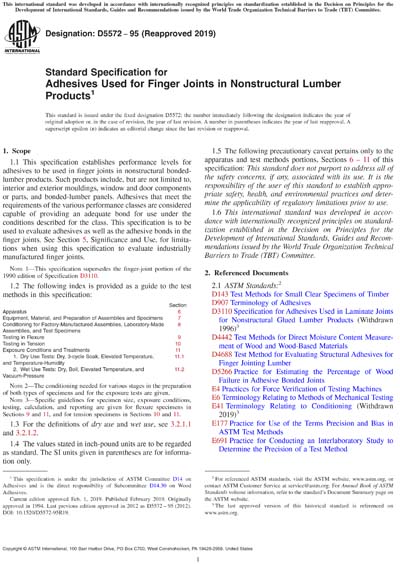Most recent
ASTM D5572-95(2019)
Standard Specification for Adhesives Used for Finger Joints in Nonstructural Lumber Products
1.1 This specification establishes performance levels for adhesives to be used in finger joints in nonstructural bonded-lumber products. Such products include, but are not limited to, interior and exterior mouldings, window and door components or parts, and bonded-lumber panels. Adhesives that meet the requirements of the various performance classes are considered capable of providing an adequate bond for use under the conditions described for the class. This specification is to be used to evaluate adhesives as well as the adhesive bonds in the finger joints. See Section 5, Significance and Use, for limitations when using this specification to evaluate industrially manufactured finger joints.
Note 1: This specification supersedes the finger-joint portion of the 1990 edition of Specification D3110.
1.2 The following index is provided as a guide to the test methods in this specification:
Note 2: The conditioning needed for various stages in the preparation of both types of specimens and for the exposure tests are given.
Note 3: Specific guidelines for specimen size, exposure conditions, testing, calculation, and reporting are given for flexure specimens in Sections 9 and 11, and for tension specimens in Sections 10 and 11.
1.3 For the definitions of dry use and wet use, see 3.2.1.1 and 3.2.1.2.
1.4 The values stated in inch-pound units are to be regarded as standard. The SI units given in parentheses are for information only.
1.5 The following precautionary caveat pertains only to the apparatus and test methods portions, Sections 6 – 11 of this specification: This standard does not purport to address all of the safety concerns, if any, associated with its use. It is the responsibility of the user of this standard to establish appropriate safety, health, and environmental practices and determine the applicability of regulatory limitations prior to use.
1.6 This international standard was developed in accordance with internationally recognized principles on standardization established in the Decision on Principles for the Development of International Standards, Guides and Recommendations issued by the World Trade Organization Technical Barriers to Trade (TBT) Committee.
ASTM International [astm]

